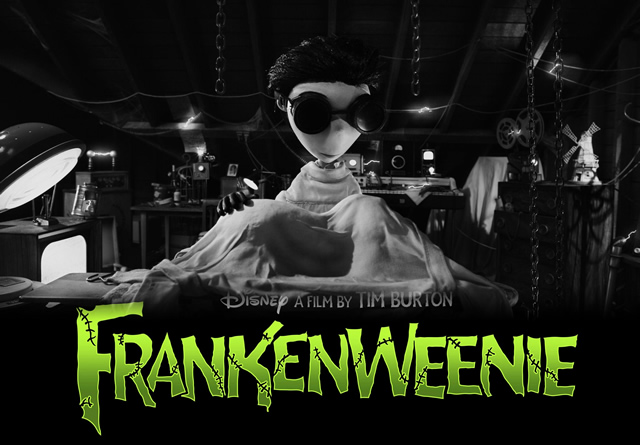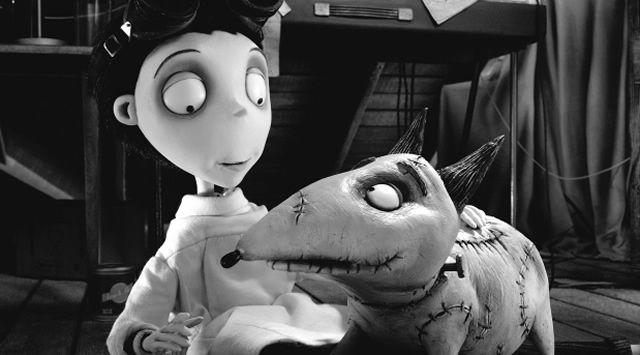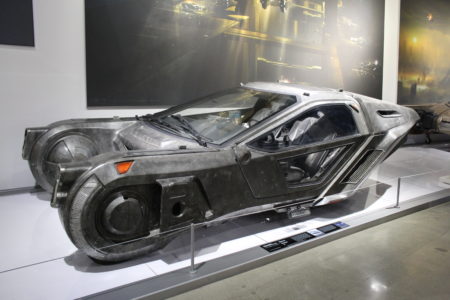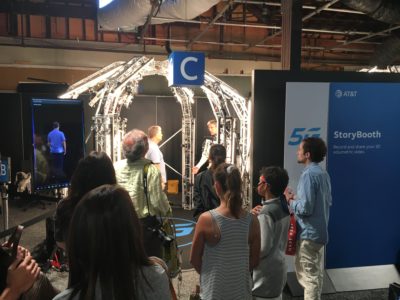If somebody had told me 20 years ago I’d be watching a Black and White film intended for young audiences by Disney I probably wouldn’t have believe it. But this is not the first time director Tim Burton has broke the mold in the film industry, and Frankenweenie is a triumphant proof that we can still get original films made.
Frankenweenie is based in a short film made by Burton while he was a young CalArts graduate working for Disney, in a time (the 80’s) when the studio was known for films like The Fox and The Hound or Benji The Hunted. It always amuses me to think of him trying to pitch his unique ideas to the studio back then: ” I want to make a short film about a dog brought back from the dead”, or even better “What about a movie about a singing skeleton who ruins Christmas?”. The studio went for the first option, and allowed him to produce the short in live action (and to my astonishment) in Black and White. But of course, there was no place along “The Brave Little Toaster” or other films alike for it.
It was after Burton made Pee Wee’s Big Adventure for Warner Bros that Disney figured this young boy’s “out of the box” ideas were actually profitable and appealed to broader audiences. In 1990 they actually gave him a green light for the “skeleton” pitch, which would become The Nightmare Before Christmas. The film revolutionized the stop-motion animation industry, and would set the bar high for future films of its kind.
But that was almost 20 years ago. Now we are the “CGI era”, and pretty much anything we can imagine we can see on screen, which came with its ups and downs. The capabilities of this technology have been exploited to a point that we are (almost) no longer surprised or amazed by anything that appears on screen: we have “seen it all”. Good or bad, we are not the same “audience” for films anymore.
That’s why a unique film can become such a precious commodity now: it’s such a big task to tackle. And Frankenweenie is that type of film.
We have had jewels in stop-motion animation since Nightmare, thanks to its director Henry Selick (Coraline), and studios like Laika (Paranorman) or Aardman (Wallace and Gromit). But what Frankenweenie does different is that is not cautious about being “too creepy” or aiming to be “too cute” to appeal to younger audiences. This film actually made me jump out of my seat a time or too, and I absolutely loved it for it.
Burton grew up watching old horror films. And this is an incredibly loving homage to an era where it was o.k. to spook you in movies, no matter your age.
To horror fans this film is a call back after the other to nostalgia: from the characters’s design (even their names) to nods to all kind of timeless gems in the genre. The cinematography, in a glorious pristine Black and White, is reminiscent of old German Expressionism masterpieces like Nosferatu or The Cabinet of Dr. Caligari.
What about general audiences? Well, I really hope they give this film a chance. It’s so fun and has so much humor in it to appeal to anyone, and I enjoyed the message behind it as well.
Beautiful and heartfelt, Frankenweenie is a love letter to the horror genre and to stop motion animation. One of the beauties of this technique is how it can stand the test of time: this film can be seen years from now and still look timeless. Just take a look at The Nightmare Before Christmas (made almost 20 years ago in 1993), which I still enjoy every year for Halloween and looks as beautiful as the first time I saw it.
Who knew a film about an “undead” dog could actually be a fascinating, moving, unique piece of cinema? I guess that’s a question for a certain once young kid from Burbank, who knew how much fun it would be to watch an skeleton kidnapping Santa Claus. Since he was right.







I really wanted to LOVE this film. Based on the fact that we both adored ParaNorman I was all set to enjoy this too. Alas it was “functional” (I hope Arcturus sees this) but the story was rather pedestrian. I wanted more character development or something to happen that would surprise me. It was ok, I gave it a pass, but it just didn’t charm me the way ParaNorman did. Nice review!
Thank you Mark 🙂 As much as I did enjoy the film I know it alienated a lot of people due its uncanny nature and plot. It feels like an horror homage to me more than a character study (which was the case with Paranorman), but I’m a fan of the genre and it didn’t bother me particularly, even though I can absolutely understand where your issues with it come from. Thank you for commenting!
Probably not the best movie to take your kiddies out to go and see, but still a fun-loving, heartfelt flick that’s a nice return to pace for Burton. I just hope he can keep it going. Nice review.
I liked the original short and I enjoyed this full length feature even more. As you stated the animation was spectacular and the story was classic Burton creepy. I struggled a bit watching this film but that was due to an allergy attack and the ill fated decision to double up on my medication.
I look forward to checking it out again prior to writing our review.
It always cracks me up that Disney fired Burton after the original short and now the Haunted Mansion ride at Disney is devoted to The Nightmare Before Christmas for about a 3rd of the year.
Great write up !
Great review! I’m really looking forward to this, and was hoping it’d be a jump back to Burton’s early days. I remember watching the short film on the Nightmare Before Christmas DVD (I think) and loving it. Can’t wait to see this now!